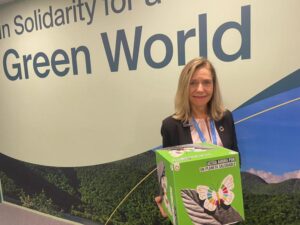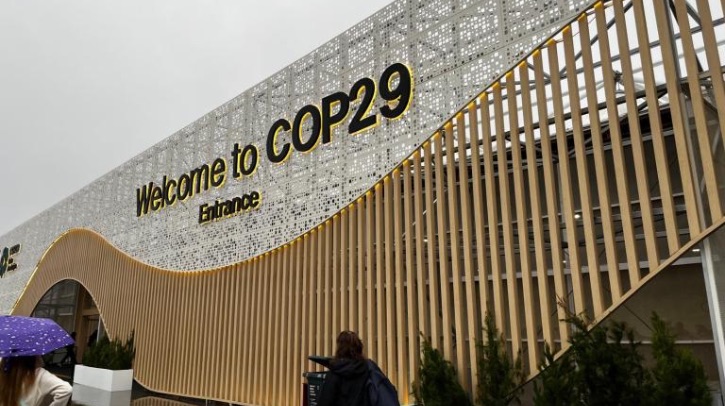The UN climate change conference has concluded with a pledge from developed nations to contribute at least US$300bn annually to support climate adaptation.
After two weeks of intense negotiations, delegates at COP29, formally the 29th Conference of Parties to the UN Framework Convention on Climate Change (UNFCCC), agreed to provide this funding annually, with an overall climate financing target to reach “at least US$1.3tn by 2035”.
This summit had been dubbed the ‘climate finance COP’, and representatives from all countries were seeking to establish a new, higher climate finance goal. The target, or new collective quantified goal (NCQG), will replace the existing US$100bn goal that is due to expire in 2025.
Key decisions
Key focus areas include scaling up the Early Warnings for All initiative to ensure comprehensive early warning coverage, and advancing Global Greenhouse Gas Watch to improve monitoring and mitigation.
Another priority is to close the gaps in Earth observations. These are necessary to inform both mitigation and adaptation, as was noted in the Subsidiary Body for Scientific and Technological Advice (SBSTA) chair’s summary. WMO will take a similar approach to closing the gaps in multi-hazard early warning systems.
Additional contributions were announced to the United Nations Systematic Observations Financing Facility (SOFF), which is now capitalized with more than US$100m to support countries in closing their basic weather and climate data gaps.
A consolidated WMO strategy to support countries in updating nationally determined contributions (NDCs) and national adaptation plans (NAPs) to reflect these elements will be developed. A critical element will be positioning national meteorological and hydrological services (NMHS) as the authoritative voice of hydro-meteorological early warnings and central actors in driving science-based solutions, ensuring their enhanced role in implementing climate policies and strategies worldwide.
Young people will be a key focus. Consultations with youth organizations on climate action will help guide the development of the WMO’s Youth Action Plan.
UN Climate Change executive secretary Simon Stiell described the new finance goal agreed at COP29 as “an insurance policy for humanity”.
“This deal will keep the clean energy boom growing and protect billions of lives,” he said. “It will help all countries to share in the huge benefits of bold climate action: more jobs, stronger growth, cheaper and cleaner energy for all. But like any insurance policy, it only works if the premiums are paid in full, and on time.
“No country got everything they wanted, and the world leaves Baku with a mountain of work to do. So this is no time for victory laps. We need to set our sights and redouble our efforts on the road to Belém.” Belém, in the eastern Amazonian region of Brazil, will host COP30 in 2025.
UN’s conclusion
Reacting to the outcome, UN secretary-general António Guterres said that although an agreement at COP29 was absolutely essential to keep the 1.5° limit alive, “I had hoped for a more ambitious outcome – on both finance and mitigation – to meet the great challenge we face. But this agreement provides a base on which to build. It must be honored in full and on time. Commitments must quickly become cash. All countries must come together to ensure the top end of this new goal is met.”
Developing countries, which had sought over US$1tn in assistance, said the pledge of financing was too little too late.
The WMO delegation at COP29, headed by secretary-general Celeste Saulo, highlighted the urgency of drastic reductions in greenhouse gas emissions – and more financing to build resilience, particularly to strengthen early warning systems.
According to the WMO’s State of the Climate Update, 2024 is on track to be the hottest on record and temporarily hit 1.5°C above the pre-industrial level. Greenhouse gas levels are at record observed levels. Sea-level rise is accelerating, glacier retreat is unprecedented, and extreme weather events have caused major loss of life and livelihoods around the world.
“The time for action is now,” said Saulo. “If you want a safer planet, it’s our responsibility. It’s a common responsibility, a global responsibility.”

The COP29 outcome is a gesture of support for the most vulnerable, Saulo said, but added that much more needs to be done.
Following COP29, WMO will prioritize accelerated action to strengthen global climate mitigation and adaptation and reduce loss and damage. It will continue leveraging its State of the Climate reports to inform climate policy, finance and action.
Other steps forward
Countries also agreed on the rules for a UN-backed global carbon market. This market will facilitate the trading of carbon credits, incentivizing countries to reduce emissions and invest in climate-friendly projects.
They agreed to an extension of a program centered on gender and climate change; and agreed on support for the least developed countries to carry out national adaptation plans.

COP29 also saw the launch of the Baku Dialogue on Water for Climate Action, a platform that promotes collaboration and initiatives that accelerate solutions for the water crisis. WMO is one of the co-founding signatories and exercises its mandate to provide robust and science-based evidence.
In related news, at COP29 in Baku, Azerbaijan, the WMO convened a top-level event on the UN secretary-general’s Early Warnings for All (EW4All) initiative, which has expanded to 30 more countries through 14 more projects. Click here to read the full story.



